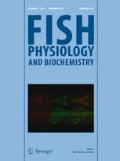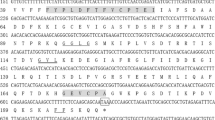Abstract
Thioredoxin (Trx) proteins are involved in several cellular processes, such as anti-oxidative stress and cellular redox homeostasis. In this study, we isolated the full-length cDNAs of PoTrx1 and PoTRP14 from Japanese flounder (Paralichthys olivaceus). PoTrx1 is 723 bp in length, with a 366-bp open reading frame (ORF) that encodes for 121 amino acids. PoTRP14 is 909 bp in length, with a 372-bp ORF that encodes for 123 amino acids. PoTrx1 and PoTRP14 are highly conserved in Cys–Gly–Pro–Cys and Cys–Pro–Asp–Cys forms, respectively. Tissue distribution analysis revealed that the transcripts of PoTrx1 and PoTRP14 were ubiquitously expressed in all tested tissues and particularly abundant in immunity-related organs, such as the liver, intestine, gill, and spleen. Development expression profiles indicated that PoTrx1 transcript was expressed from the neurula stage to the 1 day post-hatching stage; the maximum transcript levels were recorded at the somatic stage. The mRNA level of PoTRP14 was constantly expressed at all examined developmental stages, reaching the peak at the before-hatching stage. Prx1 is a peroxiredoxin family member that serves similar functions to PoTrx1 and PoTRP14. A primary hepatocyte culture system was established to examine the immunoregulatory properties of PoTrx1, PoTRP14, and Prx1 in response to lipopolysaccharide, CuSO4, and H2O2 stimulation. Results revealed that the transcript levels of PoTrx1, PoTRP14, and Prx1 were significantly up-regulated in a time-dependent manner after the immunostimulant challenge. These data suggest that PoTrx1, PoTRP14, and Prx1 play critical roles in anti-oxidation and immunoregulation.





Similar content being viewed by others
References
Alday-Sanz V, Roque A, Turnbull JF (2002) Clearing mechanisms of Vibrio vulnificus biotype I in the black tiger shrimp Penaeus monodon. Dis Aquat Organ 48:91–99
Angelini G, Gardella S, Ardy M, Ciriolo MR, Filomeni G, Di Trapani G (2002) Antigen-presenting dendritic cells provide the reducing extracellular microenvironment required for T lymphocyte activation. Proc Natl Acad Sci USA 99:1491–1496
Arnér ESJ, Holmgren A (2000) Physiological functions of thioredoxin and thioredoxin reductase. Eur J Biochem 267:6102–6109
Bishop RE (2005) Fundamentals of endotoxin structure and function. Contrib Microbiol 12:1–27
Bogdan C, Röllinghoff M, Diefenbach A (2000) Reactive oxygen and reactive nitrogen intermediates in innate and specific immunity. Curr Opin Immunol 12:64–76
Byon JY, Ohira T, Hirono I, Aoki T (2005) Use of a cDNA microarray to study immunity against viral hemorrhagic septicemia (VHS) in Japanese flounder (Paralichthys olivaceus) following DNA vaccination. Fish Shellfish Immunol 18:135–147
Chae HZ, Kim IH, Kim K, Rhee SG (1993) Cloning, sequencing, and mutation of thiol-specific antioxidant gene of Saccharomyces cerevisiae. J Biol Chem 268:16815–16821
Copley SD, Novak WR, Babbitt PC (2004) Divergence of function in the thioredoxin fold superfamily: evidence for evolution of peroxiredoxins from a thioredoxin-like ancestor. Biochemistry 43:13981–13995
De Zoysa M, Pushpamali WA, Whang I, Kim SJ, Lee J (2008) Mitochondrial thioredoxin-2 from disk abalone (Haliotis discus discus): molecular characterization, tissue expression and DNA protection activity of its recombinant protein. Comp Biochem Phys B 149(4):630–639
Debarbieux L, Beckwith J (2000) On the functional interchangeability, oxidant versus reductant, of members of the thioredoxin superfamily. J Bacteriol 182:723–727
Didier C, Kerblat I, Drouet C, Favier A, Béani JC, Richard MJ (2001) Induction of thioredoxin by ultraviolet-A radiation prevents oxidative-mediated cell death in human skin fibroblasts. Free Radic Biol Med 31(5):585–598
Fuji K, Kobayashi K, Hasegawa O, Coimbra MRM, Okamoto N (2006) Identification of a single major genetic locus controlling the resistance to lymphocystis disease in Japanese flounder (Paralichthys olivaceus). Aquaculture 254:203–210
Goedken M, De Guise S (2004) Flow cytometry as a tool to quantify oyster defence mechanisms. Fish Shellfish Immunol 16:539–552
Hwang SD, Kondo H, Hirono I, Aoki T (2011) Molecular cloning and characterization of toll-like receptor 14 in Japanese flounder, Paralichthys olivaceus. Fish Shellfish Immunol 30:425–429
Hwang SD, Ohtani M, Hikima J, Jung TS, Kondo H, Hirono I et al (2012) Molecular cloning and characterization of toll-like receptor 3 in Japanese flounder, Paralichthys olivaceus. Dev Comp Immunol 37:87–96
Hwang BO, Kim YK, Nam YK (2014) Effect of hydrogen peroxide exposures on mucous cells and lysozymes of gill tissues of olive flounder Paralichthys olivaeceus. Aquac Res 2014:1–12
Jeong W, Yoon HW, Lee SR, Rhee SG (2004) Identification and characterization of TRP14, a thioredoxin-related protein of 14 kDa. New insights into the specificity of thioredoxin function. J Biol Chem 279:3142–3150
Khayat M, Stuge TB, Wilson M, Bengtén E, Miller NW, Clem LW (2001) Thioredoxin acts as a B cell growth factor in channel catfish. J Immunol 166:2937–2943
Kim DH, Kim JW, Jeong JM, Park HJ, Park CI (2011) Molecular cloning and expression analysis of a thioredoxin from rock bream, Oplegnathus fasciatus, and biological activity of the recombinant protein. Fish Shellfish Immunol 31:22–28
Leyens G, Donnay I, Knoops B (2003) Cloning of bovine peroxiredoxins-gene expression in bovine tissues and amino acid sequence comparison with rat, mouse and primate peroxiredoxins. Comp Biochem Physiol B Biochem Mol Biol 136:943–955
Li RW, Waldbieser GC (2006) Genomic organisation and expression of the natural killer cell enhancing factor (NKEF) gene in channel catfish, Ictalurus punctatus (Rafinesque). Fish Shellfish Immunol 20:72–82
Lillig CH, Holmgren A (2007) Thioredoxin and related molecules from biology to health and disease. Antioxid Redox Signal 9:25–47
Ludemann H, Dormeyer M, Sticherling C, Stallmann D, Follmann H, Krauth-Siegel RL (1998) Trypanosoma brucei tryparedoxin, a thioredoxin-like protein in African trypanosomes. FEBS Lett 431:381–385
Martin R, Fitzl G, Mozet C, Martin H, Welt K, Wieland E (2002) Effect of age and hypoxia/reoxygenation on mRNA expression of antioxidative enzymes in rat liver and kidney. Exp Gerontol 37:1481–1487
Moriarty-Craige SE, Jones DP (2004) Extracellular thiols and thiol/disulfide redox in metabolism. Annu Rev Nutr 24:481–509
Mu C, Zhao J, Wang L, Song L, Song X, Zhang H et al (2009) A thioredoxin with antioxidant activity identified from Eriocheir sinensis. Fish Shellfish Immunol 26(5):716–723
Nakamura H, Nakamura K, Yodoi J (1997) Redox regulation of cellular activation. Annu Rev Immunol 15(1):351–369
Nho SW, Hikima J, Cha IS, Park SB, Jang HB, del Castillo CS et al (2011) Complete genome sequence and immunoproteomic analyses of the bacterial fish pathogen Streptococcus parauberis. J Bacteriol 193:3356–3366
Nkabyo YS, Ziegler TR, Gu LH, Watson WH, Jones DP (2002) Glutathione and thioredoxin redox during differentiation in human colon epithelial (Caco-2) cells. Am J Physiol Gastrointest Liver Physiol 283:1352–1359
Ooi EL, Hirono I, Aoki T (2006) Functional characterisation of the Japanese flounder, Paralichthys olivaceus, Mx promoter. Fish Shellfish Immunol 21:293–304
Park CI, Jung JH, Shim WJ, Kim JW, Kim EG, Jeong JM et al (2012) Molecular characterization, expression, and functional analysis of two thioredoxins in the black rockfish (Sebastes schlegelii). Fish Shellfish Immunol 32:808–815
Powis G, Montfort WR (2001) Properties and biological activities of thioredoxins. Annu Rev Pharmacol Toxicol 4:261–295
Raetz CR, Whitfield C (2002) Lipopolysaccharide endotoxins. Annu Rev Biochem 71:635–700
Sachi Y, Hirota K, Masutani H, Toda K, Oakahashi T, Takigawa M et al (1995) Induction of ADF/TRX by oxidative stress in keratinocytes and lymphoid cells. Immunol Lett 44:189–193
Saitoh M, Nishitoh H, Fujii M, Takeda K, Tobiume K, Sawada Y et al (1998) Mammalian thioredoxin is a direct inhibitor of apoptosis signal-regulating kinase (ASK) 1. EMBO J 17:2596–2606
Saitou N, Nei M (1987) The neighbor-joining method: a new method for reconstructing phylogenetic trees. Mol Biol Evol 4(4):406–425
Sauer H, Wartenberg M, Hescheler J (2001) Reactive oxygen species as intracellular messengers during cell growth and differentiation. Cell Physiol Biochem 11(4):173–186
Shin DH, Fujiki K, Nakao M, Yano T (2001) Organization of the NKEF gene and its expression in the common carp (Cyprinus carpio). Dev Comp Immunol 25:597–606
Simon HU, Haj-Yehia A, Levi-Schaffer F (2000) Role of reactive oxygen species (ROS) in apoptosis induction. Apoptosis 5(5):415–418
Song L, Wang L, Qui L, Zhang H (2010) Bivalve immunity. In: Söderhäll K (ed) Advances in experimental medicine and biology—invertebrate immunity, vol 708. Landes Bioscience, Texas, pp 44–65
Spector A, Yan GZ, Huang RR, McDermott MJ, Gascoyne PR, Pigiet V (1988) The effect of H2O2 upon thioredoxin-enriched lens epithelial cells. J Biol Chem 263:4984–4990
Sun J, Li Y, Sun L (2012) Cynoglossus semilaevis thioredoxin: a reductase and an antioxidant with immunostimulatory property. Cell Stress Chaperones 17:445–455
Tamura K, Peterson D, Peterson N, Stecher G, Nei M, Kumar S (2011) MEGA5: molecular evolutionary genetics analysis using maximum likelihood, evolutionary distance, and maximum parsimony methods. Mol Biol Evol 28(10):2731–2739
Tanekhy M, Matsuda S, Itano T, Kawakami H, Kono T, Sakai M (2010) Expression of cytokine genes in head kidney and spleen cells of Japanese flounder (Paralichthys olivaceus) infected with Nocardia seriolae. Vet Immunol Immunopathol 134:178–183
Tiscar P, Mosca F (2004) Defense mechanisms in farmed marine molluscs. Vet Res Commun 28:57–62
Touati D (2000) Iron and oxidative stress in bacteria. Arch Biochem Biophys 37:31–36
Wahl MC, Irmler A, Hecker B, Schirmer RH, Becker K (2005) Comparative structural analysis of oxidized and reduced thioredoxin from Drosophila melanogaster. J Mol Biol 345:1119–1130
Wang XW, Liou YC, Ho B, Ding JL (2007) An evolutionarily conserved 16-kDa thioredoxin-related protein is an antioxidant which regulates the NF-kB signaling pathway. Free Radic Biol Med 42:247–259
Wei J, Guo M, Ji H, Yan Y, Ouyang Z, Huang X et al (2012) Cloning, characterization, and expression analysis of a thioredoxin from orange-spotted grouper (Epinephelus coioides). Dev Comp Immunol 38:108–116
Wei J, Ji H, Guo M, Yan Y, Qin Q (2013) Identification and characterization of TRP14, a thioredoxin-related protein of 14 kDa from orange-spotted grouper, Epinephelus coioides. Fish Shellfish Immunol 35:1670–1676
Wollman EE, D’Auriol L, Rimsky L, Shaw A, Jacquot JP, Wingfield P et al (1988) Cloning and expression of a cDNA for human thioredoxin. J Biol Chem 263:15506–15512
Yegorova S, Liu A, Lou MF (2003) Human lens thioredoxin: molecular cloning and functional characterization. Invest Ophthalmol Vis Sci 44:3263–3271
Zhang P, Liu B, Kang SW, Seo MS, Rhee SG, Obeid LM (1997) Thioredoxin peroxidase is a novel inhibitor of apoptosis with a mechanism distinct from that of Bcl-2. J Biol Chem 272:30615–30618
Zhang H, Evenhuis JP, Thorgaard GH, Ristow SS (2001) Cloning, characterization and genomic structure of the natural killer cell enhancement factor (NKEF)-like gene from homozygous clones of rainbow trout (Oncorhynchus mykiss). Dev Comp Immunol 25:25–35
Zhong Q, Zhang Q, Wang Z, Qi J, Chen Y, Li S et al (2008) Expression profiling and validation of potential reference genes during Paralichthys olivaceus embryogenesis. Mar Biotechnol 10:310–318
Acknowledgments
This work was supported by the National High-Tech Research and Development Program (2012AA10A402) and the National Science Foundation of China (31172385).
Author information
Authors and Affiliations
Corresponding author
Rights and permissions
About this article
Cite this article
Yuan, J., Jiang, J., Jiang, L. et al. Insights into Trx1, TRP14, and Prx1 homologs of Paralichthys olivaceus: molecular profiles and transcriptional responses to immune stimulations. Fish Physiol Biochem 42, 547–561 (2016). https://doi.org/10.1007/s10695-015-0158-2
Received:
Accepted:
Published:
Issue Date:
DOI: https://doi.org/10.1007/s10695-015-0158-2




